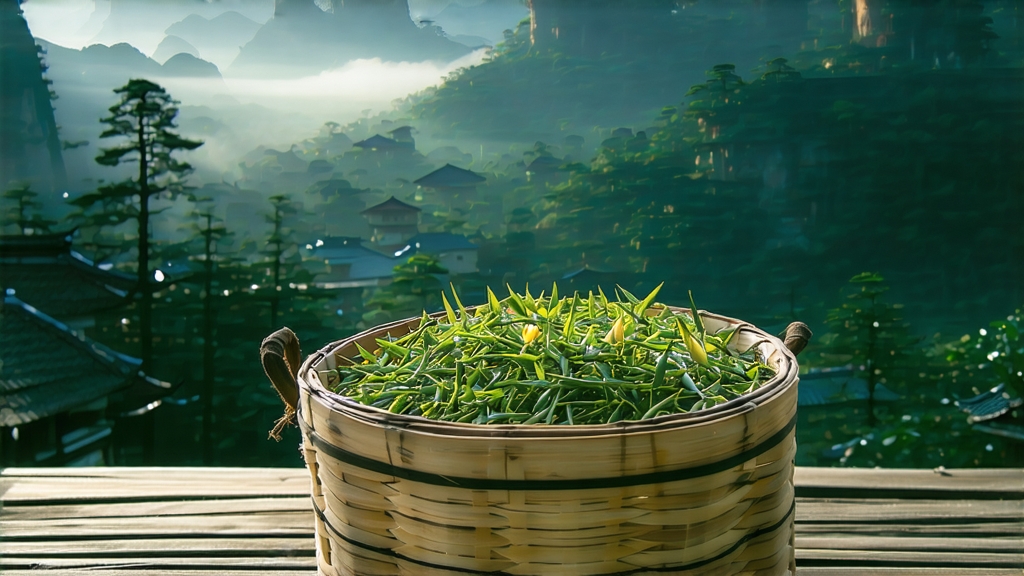
Tucked high above the Sichuan basin, where perpetual cloud veils the summit of Meng Ding Mountain, a tea once reserved for emperors still unfurls its single, down-covered bud each April. International drinkers may speak freely of Longjing or Pu-erh, yet few have tasted Meng Ding Huang Ya, the “Yellow Bud” whose subtle name hides a pedigree as lustrous as its liquor. This essay invites the curious palate on a complete journey—from Tang-dynasty court chronicles to the modern gaiwan—so that the forgotten yellow category can at last step into the global light.
-
A leaf enters history
Meng Ding Shan, “the misty summit,” rises 1 450 m at the western edge of the Chengdu plain. Monsoon clouds arriving from the Tibetan Plateau stall here, bathing ancient camellia groves in 200 foggy days a year. The first written record appears in 825 CE when Tang emperor Jingzong accepted a spring tribute of “yellow sprouts from Meng Prefecture,” praising their honeyed quietness over the more astringent green teas of Zhejiang. By the Song dynasty the buds were packed in silver-foil cylinders, couriered overnight along post-roads to Bianjing, and served only after the emperor had burned incense to the God of Tea. When Ming Hongwu later abolished compressed tribute cakes, loose Huang Ya survived because its gentle oxidation matched the new infusion fashion. A 1555 county gazetteer notes that one liang (40 g) exchanged for the same weight of silver, making the mountain farmers “wealthier than low-ranking mandarins.” After 1911 the imperial order collapsed, markets turned to black tea for export, and Meng Ding Huang Ya retreated into local memory until a 1959 state campaign sought to revive “China’s classical six colours.” Today only 120 ha of certified gardens remain, producing barely 18 t a year—rarer per gram than silver-tipped Darjeeling. -
Of yellow teas and their quiet family
Western catalogues often miscall any pale Chinese brew “yellow tea,” yet the category is defined by one irreplaceable step: sealed yellowing (men huang), a controlled post-fixation humid rest that steals green harshness while stopping short of black oxidation. Within this narrow family Meng Ding Huang Ya occupies the “bud-only” apex, alongside Jun Shan Yin Zhen of Hunan and Huo Shan Huang Ya of Anhui. What distinguishes it is altitude-induced succulence: the mountain’s UV-B light is 30 % weaker than plains at the same latitude, prompting the plant to synthesize more theanine and less catechin. The result is a naturally creamy amino backbone that later accepts yellowing without turning grassy. -
Crafting gold from green: the 48-hour breath
Harvest begins when the dawn mist still beads on the rows. Pickers—each wearing a bamboo rain cape to keep body steam off the leaf—pluck only the unopened bud and its half-open first leaf, a standard called “one flag, one spear.” Within thirty minutes the basket is carried to the mountain-top courtyard where three successive fir-tube stoves wait.
Step 1: 160 °C pan fixation lasts 4 min, just long enough to silence leaf enzymes while preserving a 5 % residual moisture—higher than green tea, essential for later transformation.
Step 2: Initial rolling on a bamboo tray is done with the fingertips, never the palm, to avoid crushing the pubescent down that will give the dried bud its golden glow.
Step 3: Sealed yellowing is the soul. The leaves are piled 3 cm deep inside a cedar box lined with wet cotton; the lid is closed and the box slid above a brazier whose charcoal holds 45 °C for 70 min. Here chlorophyll gently breaks into pheophytin, polyphenols dimerise, and a popcorn-like aroma first appears. The process is repeated three times with 30 min air rests, each cycle lowering moisture by 1 %. Mastery lies in reading the leaf: too hot and the bud reddens like oolong; too cool and grassy notes return.
Step 4: Low-temperature desiccation at 60 °C finishes the tea while locking in a 4 % final moisture, low enough for mountain storage yet high enough to allow graceful ageing. From pluck to finished bud no more than 48 hours elapse, a window so tight that Meng Ding Huang Ya is made